What’s driving innovation in lighting towers?
20 November 2024
Demand for sustainable and compact units is growing, and some OEMs are experimenting with new designs. Lewis Tyler reports.
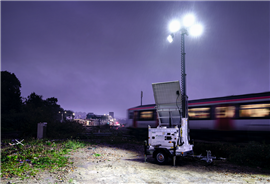 The generator of the ProRXM Hybrid starts up automatically when power demands exceed the battery charge. Photo: Prolectric
The generator of the ProRXM Hybrid starts up automatically when power demands exceed the battery charge. Photo: Prolectric
“As we head into autumn and winter and the nights draw in, tower lights become the most essential, versatile and functional components to extend construction hours after dark.”
The above is a statement from Kathryn Adams, commercial director for solar and battery specialist Prolectric.
The company is one of a number of OEMs that are developing solar, battery and hybrid units off the back of demand for carbon saving units.
For its part, the company launched the ProRXM Hybrid at the beginning of 2024. The unit is fully powered by three 270W solar panels with 8kWh of usable battery bank storage, while a DC 2.8kW generator utilises 0.5 litres per hour.
The generator starts up automatically when power demands exceed the battery charge.
Four multi-directional 180W LED lights on a 360° pan motor rotatable hydraulic mast can be dimmed, monitored and scheduled remotely thanks to the company’s remote monitoring and reporting software.
Prolectric said the unit is designed to meet market demand for a hybrid product.
“Tower lights are traditionally powered using fossil fuels and a diesel engine, but more recently through sustainable solutions which include solar or hybrid power,” says Adams.
“Prolectric’s ProRXM Hybrid will routinely perform throughout an entire year with on only a single tank of diesel, saving customers thousands on diesel and refuelling costs.”
Demand for alternative-powered lighting towers
Another company noting an increase in demand for units that offer different power methods is Italy-headquartered Trime.
The company told IRN that it places a particular emphasis on designing and producing low-emission hybrid and solar-only lighting towers, which are marketed under its T-ZERO brands.
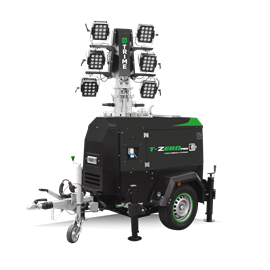 X-ECO HYBRID LITHIUM is powered by advanced lithium battery technology that can be fully recharged in three hours. Photo: Trime
X-ECO HYBRID LITHIUM is powered by advanced lithium battery technology that can be fully recharged in three hours. Photo: Trime
Following what it describes as “unprecedented demand, principally from the global rental markets,” the manufacture of their X-ECO HYBRID LITHIUM lighting tower has for the first time outstripped its diesel-powered equivalent.
The X-ECO HYBRID LITHIUM is powered by advanced lithium battery technology that can be fully recharged in three hours with the lights off and three and a half hours with the lights on.
According to Trime, this means that in a 14 and half-hour cycle, for 80% of the operation, the X- ECO HYBRID LITHIUM is powered exclusively by its batteries and therefore emits zero noise and zero carbon emissions.
The unit is also suited to light up movie sets, television productions, outside events, highway projects, construction sites and trackside, the company added.
Ireland’s FK Lowry Plant has recently invested in a fleet of X-ECO HYBRID LITHIUM sets supplied by Trime’s Ireland distributor Glendun Plant, while Boels Rental has purchased over 200 of the lighting towers.
According to Gary Darley, managing director of Boels Rental UK, the sustainability of the units was a key driver behind the investment; “We selected the Trime X-ECO HYBRID LITHIUM lights because of their sustainability features and their high-quality design and manufacture. Our customers value the cost-effectiveness of the Trime products. We exclusively run only Trime tower lights in the Boels Rental UK fleet.”
Diesel demand
Aside from alternative-powered options, demand for compact units that are durable and can be easily transported is also increasing at a pace.
In June, Spain-based manufacturer HIMOINSA launched its new HCOMPACT+ mobile unit. With a lumen output of 6,400 m2 at an average of 20 lux, the HCOMPACT+ is fitted with 4 x 350W LED lamps (50X50 SMD Chip Technology). Its hydraulically raised telescopic mast reaches a height of 8.3 metres and can rotate through 360°, thus guaranteeing optimum light coverage, the company said..
The tower is powered by a Yanmar 2TNV70 two-cylinder engine with optimised fuel consumption of less than 0.55 l/h that features a large capacity tank with a running time of 400 hours and 600 hour service intervals.
Its compact design is also said to enable large openings for easy maintenance and a wide hinged door and removable ventilation grilles for easy cleaning.
Another key feature, according to HIMOINSA, is the CET8 controller that enables simple and reliable use of the machine.
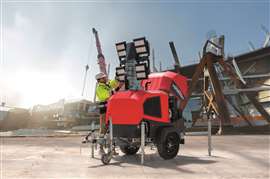 The HCOMPACT+ is powered by a Yanmar 2TNV70 two-cylinder engine. Photo: Himoinsa
The HCOMPACT+ is powered by a Yanmar 2TNV70 two-cylinder engine. Photo: Himoinsa
It includes an automatic working mode (Start/Stop), engine Run/Stop, mast Up/Down and lamps On/Off, as well as the reverse when the stop is activated. With the controller, users can also raise and lower the mast by using its joystick.
The HCOMPACT+ is also equipped with CAN BUS, which means that the operator can connect to the C4Cloud fleet management module to remotely control the units. The new design also features a remote cooling
system which is said to guarantee sound emissions as low as 53 dB(A) at 7 metres, as well as increased durability and residual value. Miguel Angel Ruiz, global engineering & development head at HIMOINSA, said, “We have worked hard to develop a design that
isolates the engine area from the rest of the unit, creating an independent space, well away from the air flows, thereby reducing the intake of dust, water and other substances, and ensuring that the engine, the filters and indeed all the other components can have a longer service life.”
LED balloon lighting
While traditional lighting towers remain popular, and take up the majority of the market, a number of OEMs are experimenting with new designs.
Take for example US-based LED balloon lighting manufacturer Volterrex. Founded in 2019, the company is focusing its attention on balloon light towers and balloon work towers for the construction, events and disaster relief sectors respectively.
According to the company, it designed its range of ballon lights to deliver “extremely bright yet diffused illumination” to increase productivity and maximise safety for indoor and outdoor construction sites, night time road work, and more.
The range, which offers between 7,800 lumens at the lower end and 19,500 lumens at the higher end, features an inflatable diffusion balloon that is said to eliminate the harsh glare of halogen lights to mitigate eye-strain for workers.
In terms of set up, the diffusion balloon inflates with an integrated fan that pairs with an internal heat sync to keep the light cool to the touch and work sites from overheating under traditional halogen lights that can become a fire hazard.
Nicholas Palumbo, general manager, Volterrex by ISM Lighting, said, “Commercial light towers have long been a valuable product offering for commercial rental companies, but traditional halogen light solutions often require extensive maintenance, demand a lot of energy for continuous operation, and become so hot they can make indoor work zones uncomfortable or become fire hazards themselves.
“We saw an opportunity to reinvent commercial light towers that are more durable, more energy efficient and stay cool to the touch, all while eliminating the harsh light that strains workers’ eyes and can temporarily blind passing vehicles.”
Autonomous lighting towers
Meanwhile, Blue Vigil, a developer of autonomous safety technology, is set to launch beta trials of its new Autonomous Aerial LED (ALED) person-portable light powered by drone technology later this year with contractors and rental dealers in the US.
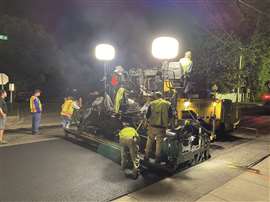 The Volterrex balloon range is designed to increase productivity and maximise safety for indoor and outdoor construction sites. Photo: Volterrex
The Volterrex balloon range is designed to increase productivity and maximise safety for indoor and outdoor construction sites. Photo: Volterrex
The company’s ALED is described as a compact area lighting system that mounts a high-intensity LED array on a tethered Unmanned Aerial Vehicle (UAV), positioning the light between 40ft (12m) and 100ft (30.5m) above a site.
The ALED covers 8,000sq ft of light on the ground and is able to be powered either by wall/shore power, generator or a vehicle inverter.
The use of the tether for power is said to allow the light to remain in position for as long as needed, while the company said that as the drone enables the site to be lit from directly above, users benefit from improved light field size and quality.
In terms of portability, Blue Vigil said it can be positioned more optimally on a site thanks to a person-portable wheeled case, reducing the need for heavy light towers in areas where they aren’t needed.
Robert Schumann, CEO, Blue Vigil, said, “Times have changed. Not only is there a massive infrastructure transformation underway, but climate conditions are making the world hotter, and more work is being done at night and in early morning when there is little to no light.
“Poor lighting is a major contributing factor to safety incidents, productivity loss and quality issues on nighttime sites. Our ALED represents the first significant advancement of portable light towers in nearly 40 years.
“The modern day worksite requires a new approach: new high-tech tools that extend the daylight hours allowing for more nighttime construction offering better quality with more efficiency. We believe rental users will be increasing their work during these hours, and they will need the tools to support them.”
Blue Vigil told IRN that although North America is the focus in the short-term, it will open up in new regions once the product gets into full production based on demand.
Generac extends GLT range
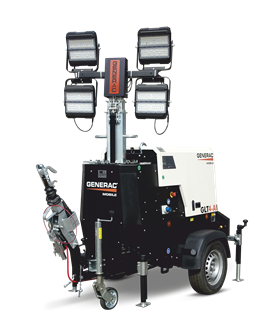
Following the launch of its GLT Series at the beginning of the year, Generac has extended the range of mobile lighting towers to six with the addition of the GLT4-A Hybrid and GLT4-M Hybrid models.
Both are powered by a hybrid system consisting of a fuel-efficient 2-cylinder engine and a powerful AGM battery pack.
Designed more for the European rental market, the GLT4-A Hybrid replaces the VT-Hybrid, which was the first hybrid lighting tower in the world.
The GLT4-A Hybrid introduces new features such as more powerful LED floodlights (increasing from 120 to 240W each) and the ability to manually adjust the light output of the floodlights to prioritise the extension of the illuminated area or the duration of the running time according to the need of the moment.
Meanwhile, the company said the GLT4-M Hybrid model is the first example of an entry-level hybrid lighting tower, designed for customers who are starting to switch from standard diesel-powered models to more environmentally friendly solutions.
It is equipped with a manually raised vertical mast and a low-speed construction trailer, while the hybrid features are the same as those of its hydraulic counterpart.
CONNECT WITH THE TEAM





